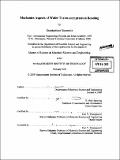| dc.contributor.advisor | S. Mark Spearing. | en_US |
| dc.contributor.author | Stamoulis, Konstantinos, 1970- | en_US |
| dc.contributor.other | Massachusetts Institute of Technology. Dept. of Materials Science and Engineering. | en_US |
| dc.date.accessioned | 2006-03-24T18:34:30Z | |
| dc.date.available | 2006-03-24T18:34:30Z | |
| dc.date.copyright | 2005 | en_US |
| dc.date.issued | 2005 | en_US |
| dc.identifier.uri | http://hdl.handle.net/1721.1/30260 | |
| dc.description | Thesis (S.M.)--Massachusetts Institute of Technology, Dept. of Materials Science and Engineering, 2005. | en_US |
| dc.description | Includes bibliographical references (leaves 77-81). | en_US |
| dc.description.abstract | Wafer-level, thermocompression bonding is a promising technique for microelectromechanical systems (MEMS) packaging. The process is a form of solid-state joining and requires the simultaneous application of temperature and pressure to wafers patterned with metallic thin films in order to bring the mating surfaces into atomic proximity. The quality of the resulting bond is critically dependent on the interaction between flatness deviations that range from wafer bow to surface roughness, the thin film properties and the process parameters and tooling used to achieve the bonds. Hitherto there has been limited modeling applied to understand the relative contributions of these effects. This thesis addresses the above issue through the development of a mechanics-based framework that allows the effect of flatness deviations to be assessed for typical geometries and process conditions. The strain energy release rate associated with the elastic deformation required to overcome wafer bow is calculated. A contact yield criterion is used to examine the pressure and temperature conditions required to flatten surface roughness asperities in order to achieve bonding over the full apparent area. The results are compared to experimental data of bond yield and toughness obtained from four-point bend delamination testing, microscopic observations and measurements on the fractured surfaces. Conclusions from the modeling and experiments indicate that wafer bow has negligible effect on determining the variability of bond quality and that the well-bonded area is increased with increasing bonding pressure. | en_US |
| dc.description.abstract | (cont.) The enhanced understanding of the underlying deformation mechanisms allows for a better controlled trade-off between the bonding pressure and temperature. | en_US |
| dc.description.statementofresponsibility | by Konstantinos Stamoulis. | en_US |
| dc.format.extent | 81 leaves | en_US |
| dc.format.extent | 3712800 bytes | |
| dc.format.extent | 3721575 bytes | |
| dc.format.mimetype | application/pdf | |
| dc.format.mimetype | application/pdf | |
| dc.language.iso | eng | en_US |
| dc.publisher | Massachusetts Institute of Technology | en_US |
| dc.rights | M.I.T. theses are protected by copyright. They may be viewed from this source for any purpose, but reproduction or distribution in any format is prohibited without written permission. See provided URL for inquiries about permission. | en_US |
| dc.rights.uri | http://dspace.mit.edu/handle/1721.1/7582 | |
| dc.subject | Materials Science and Engineering. | en_US |
| dc.title | Mechanics aspects of water thermocompression bonding | en_US |
| dc.type | Thesis | en_US |
| dc.description.degree | S.M. | en_US |
| dc.contributor.department | Massachusetts Institute of Technology. Department of Materials Science and Engineering | |
| dc.identifier.oclc | 60843022 | en_US |
